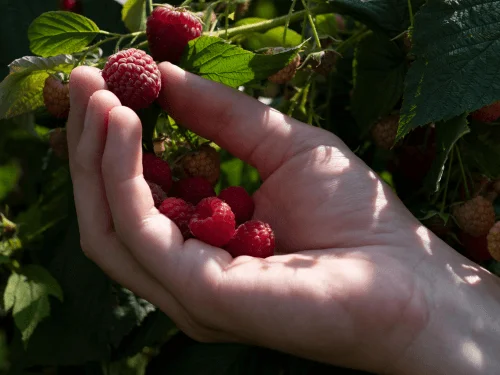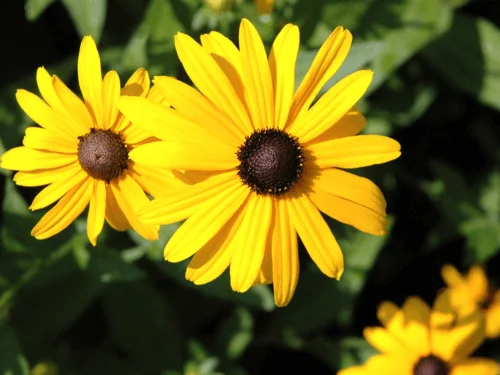A Complete Guide to Growing Chamomile

1. What is the best way to grow raspberries?
Raspberries grow best when planted in a sunny garden with well-draining soil. You can start by planting bare-root or potted plants in early spring or late fall. Rows of raspberries should be spaced about 2 to 3 feet apart within a row and 8 feet between rows. Using a trellis or support system helps canes grow upright and promotes healthy berry production.
2. How do I plant raspberries?
When planting raspberries, place the crown of the plant 1 or 2 inches above the ground. For bare-root plants, spread the roots in a hole and cover gently with soil. For potted plants, plant at the same depth as they were in the container. Make sure each bush has space to spread so new shoots and suckers can grow without overcrowding. Raspberries are easy to grow, but giving them proper spacing and sunlight ensures your raspberry patch thrives.
3. When do raspberries grow fruit?
Raspberries are perennials, and the first year canes mostly focus on root and cane growth. Summer raspberries (summer-bearing) produce fruit on two-year-old canes, typically in early summer. Fall-bearing raspberries (everbearing) can produce a crop in the fall of the first year, and another in the following summer from the same primocanes. With proper care, a bush can produce fruit in both summer and fall, giving you fresh raspberries for pies, tarts, or eating straight from the garden.
1. Are black-eyed Susans perennials or annuals?
Rudbeckia hirta, the traditional black-eyed Susan, is a biennial or short-lived perennial that often acts like an annual due to self-seeding. Some cultivars like Rudbeckia fulgida are true perennials that return every year.
2. When do black-eyed Susans bloom?
They typically bloom from early summer to early fall, filling your garden with bright yellow petals and dark black eyes. Regular deadheading encourages continuous flowering throughout the season.
3. How do I plant black-eyed Susan seeds?
Scatter Rudbeckia hirta seeds directly on the soil surface and press them lightly, as they need light to germinate. Keep the soil moist, and seedlings will appear within 7–21 days.
4. Can I grow black-eyed Susans indoors or in containers?
Yes. You can grow black-eyed Susans in containers indoors or outdoors. Use a regular seed starting mix, ensure proper drainage, and place them in a sunny location for maximum blooms.
1. What do yellow flowers symbolize?
Yellow flowers often represent friendship, positivity, and joy. They’re ideal for celebrating success, expressing gratitude, or brightening someone’s day.
2. Do yellow flowers attract pollinators?
Absolutely! Sunflowers, coreopsis, and goldenrod are magnets for bees, butterflies, and other beneficial insects.
3. Can yellow flowers grow in partial shade?
Yes, lilies and calla lilies tolerate partial sunlight, making them great for slightly shaded gardens.
4. How can I extend the bloom time of yellow flowers?
Deadhead spent flower heads, keep soil nutrients balanced, and ensure proper watering to promote continuous blooms.
If you're a tea lover, you've likely experienced the soothing magic of chamomile. But did you know that growing your own chamomile is surprisingly easy, even for beginners? Imagine stepping into your garden to pick fresh chamomile flowers whenever you want to brew a calming cup of tea.
This complete guide will walk you through everything you need to know to cultivate your own chamomile haven, from planting seeds to harvesting those beautiful, daisy-like blooms. Whether you have a spacious backyard or a sunny windowsill, growing chamomile is a rewarding way to enjoy this beloved herb.
Perfect Conditions for a Happy Chamomile

- Sunlight: Chamomile thrives in full sun, soaking up at least six hours of direct light each day. In particularly hot climates, you can give it a bit of afternoon shade to protect it from intense heat.
- Soil: This herb prefers well-draining soil that's rich in nutrients. If your soil is heavy clay or sandy, mix in some compost to improve its texture and fertility. Chamomile likes slightly acidic to neutral soil, ideally with a pH between 5.6 and 7.5.
- Water: Consistent moisture is key, but don't drown your chamomile! Aim for about an inch of water per week, adjusting depending on rainfall and temperature. Check the soil with your finger; if it feels dry an inch below the surface, it's time to water.
- Temperature: Chamomile is a cool-weather lover, happiest when daytime temperatures are around 60-70°F (15-21°C). It can handle some heat, but in very warm climates, providing afternoon shade can help it stay healthy.
Planting Your Chamomile

1. Choose Your Planting Method
- Seeds (Indoors): Starting seeds indoors gives you a head start. This is ideal if you have a shorter growing season or want to ensure a strong start for your chamomile plants.
- Seeds (Outdoors): Direct sowing outdoors is simpler but requires a bit more patience as the seeds germinate. This is a great option if you have a longer growing season and plenty of space.
- Seedlings: Buying seedlings is the fastest way to get your chamomile garden going. This is perfect if you want quick results or if starting seeds seems daunting.
2. Prepare Your Planting Site
- Location: Choose a spot that gets at least six hours of sunlight per day. If you live in a hot climate, some afternoon shade can be beneficial.
- Soil Preparation: Loosen the soil to a depth of about 12 inches. Mix in compost or other organic matter to improve drainage and fertility. If your soil is heavy clay, add some sand to help it drain better. If it's sandy, add some compost to help it retain moisture.
3. Plant Your Chamomile
- Seeds (Indoors):
- Fill seed trays or small pots with seed-starting mix.
- Moisten the soil.
- Sprinkle chamomile seeds on the surface of the soil. Do not cover them, as they need light to germinate.
- Gently press the seeds into the soil.
- Cover the trays or pots with plastic wrap to create a warm, humid environment.
- Place the trays or pots in a warm location with indirect sunlight.
- Keep the soil moist but not soggy.
- After about 7-14 days, the seeds should germinate.
- Once the seedlings have developed their first set of true leaves, you can transplant them to individual pots or outdoors after the last frost.
- Seeds (Outdoors):
- After the last frost, scatter the seeds over the prepared soil.
- Lightly rake the soil to cover the seeds.
- Water the area gently.
- Thin the seedlings to 8-12 inches apart once they are a few inches tall.
- Seedlings:
- Dig holes that are slightly larger than the root ball of the seedlings.
- Space the holes 8-12 inches apart.
- Gently remove the seedlings from their containers and place them in the holes.
- Fill the holes with soil and gently firm it around the base of the plants.
- Water the seedlings well.
4. Water and Mulch
- Water: Water your chamomile regularly, especially during hot, dry periods. Aim for about an inch of water per week.
- Mulch: Apply a layer of mulch around the plants to help retain moisture, suppress weeds, and keep the soil cool.
Caring for Your Chamomile
.webp)
- Pruning: Deadhead (remove) spent flowers to encourage more blooms. After the main flowering period, you can cut back the plants by about a third to promote bushier growth.
- Winter Care: In mild climates, chamomile may survive the winter without much fuss. In colder areas, mulch around the plants to protect their roots from frost. If you're growing chamomile in pots, you can bring them indoors for the winter.
Harvesting Your Chamomile Bounty

1. Timing is Key
- Look for: Fully open flowers with petals that are lying flat, not drooping down. The center of the flower (the yellow disk) should be slightly raised.
- When: Harvest in the morning after the dew has dried, but before the sun gets too hot. This helps to preserve the essential oils that give chamomile its fragrance and benefits.
2. Gather Your Supplies
- A clean pair of scissors or pruning shears.
- A basket or container to hold your harvest.
3. Pick with Care
- Locate: Find a flower that meets the criteria above (fully open, flat petals, raised center).
- Grasp: Gently hold the stem of the flower just below the flower head.
- Snip: Use your scissors or shears to cut the stem just below the flower head.
- Repeat: Continue harvesting until you have enough flowers for your needs. Be sure to leave some flowers on the plant to ensure continued blooming.
Troubleshooting Common Issues

- Aphids: These tiny insects can suck the sap from your plants. If you see them, blast them off with a strong spray of water or use insecticidal soap.
- Spider Mites: These pests can also weaken plants. Increase humidity by misting the plants, and use insecticidal soap or neem oil if needed.
- Powdery Mildew: This fungal disease shows up as a white, powdery coating on leaves. Ensure good air circulation by spacing plants properly and remove any affected leaves.
FAQs: Frequently Asked Questions
Q: Is chamomile easy to grow from seed?
A: Chamomile is an easy-to-grow herb that thrives in the garden. You can start chamomile from seed indoors or sow them directly in the ground during the spring. Both common chamomile and German chamomile grow in similar conditions and are easy to care for.
Q: When should I plant chamomile, and when should I harvest chamomile flowers?
A: The best time to plant chamomile is in the spring after the last frost. You can harvest chamomile flowers throughout the summer and fall as they bloom. Pick chamomile flowers with yellow centers and white petals when they are fully open.
Q: What are the best tips for how to grow chamomile in my herb garden?
A: Chamomile likes full sun and well-draining soil. It's a great companion plant for many vegetables and herbs. To care for chamomile, ensure it has enough water and deadhead the flowers to encourage new buds. Chamomile plants can quickly become invasive, so it's important to control their spread.
Q: Can I grow chamomile indoors?
A: Yes, you can grow chamomile indoors! Start chamomile seeds in a pot that is at least 6 inches deep and place it in a sunny location. Make sure the soil stays moist and well-drained. Young chamomile plants can also be transplanted into larger pots.
Q: How do I use chamomile? Can I make chamomile tea with homegrown chamomile?
A: Chamomile is used for various purposes. The daisy-like flowers with white petals and yellow centers can be used fresh or dried to make soothing chamomile tea. Chamomile flowers can also be used to make tinctures, salves, and other natural remedies. Homegrown chamomile makes delicious tea! Simply steep a few fresh or dried flowers in hot water for a relaxing cup of chamomile tea.




